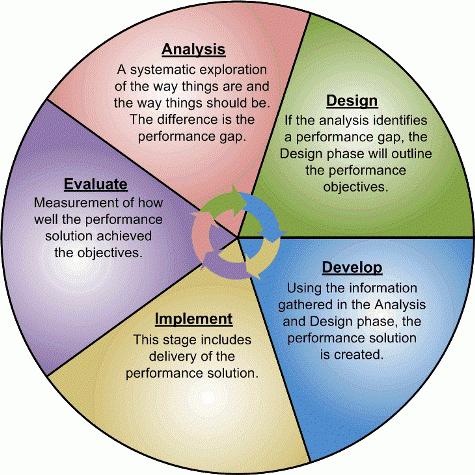ADDIE: Relic or Still Relevant?
by Niké Basurto
Prior to starting the MATD program at Roosevelt, most of my training and organizational experiences came from someone at work saying, “Hey, we need this. Can you do it?”. Therefore, I’m constantly grilling, er, speaking with instructional design professionals about their experiences. One theme that has come up frequently in these discussions is that the ADDIE instructional design methodology is rarely replicated in the workplace the way it is taught in school. To be honest, I freaked out just a teeny tiny bit. What if the way I learned instructional design was antiquated? What if I show up to job interview sounding like I’m from 1976?

Before we delve too deeply into grad student angst, let’s take a second to review some basics. The image below offers a quick primer on ADDIE for readers who are unfamiliar with this instructional design approach. ADDIE is an acronym for Analysis, Design, Develop, Implement and Evaluate. It maps out a path to instructional design that works to ensure that the design process flows as seamlessly as possible from one action to the next, building on the work of the previous step.

I sought to answer the question of relevance by polling colleagues and classmates via LinkedIn and researching the topic online. The consensus, in my unscientific LinkedIn poll, was that although ADDIE was not used stringently, it was the basis of other methodologies. Reasons for using these offshoot approaches varied, but a consistent theme of time and budget constraints were cited.
After combing the Internet, I uncovered some useful articles that mirrored my polling. ADDIE is not irrelevant; it is evolving and still very much in use. Rapid prototyping, SAM/Agile and other in-house developed processes are often employed more frequently. Faster outputs with fewer revisions and a need for ongoing evaluation of the process, and product seem to be driving the changes (Gutierrez, 2015; Pappas, 2015).
Well, there you have it. ADDIE is still alive and kicking. It looks like we will be using it or a close cousin of it for years to come. Hurrah! I won’t seem like a 70’s throwback in my job interviews. I should have known Roosevelt University would not let me down.
Continue the Conversation
What has your experience with ADDIE been? Good? Bad? Ugly?
Do you wish you had read another blog post, because duh, so obvious? Why or why not?
References and Links
ADDIE Solutions. (n.d.).The Addie Model. (n.d.). Retrieved November 21, 2016, from http://addiesolutions.com/blog/addie
Bottom Line Performance. (2016). Agile vs ADDIE: Which Is Better for Learning Design? Retrieved November 21, 2016, from http://www.bottomlineperfomance.com/agile-vs-addie-which-is-better-for-learning-design/
Gutierrez, K. (2015, July 9). The Ins and Outs of Rapid Prototyping for eLearning. Retrieved November 21, 2016, from http://info.shiftelearning.com/blog/rapid-prototyping-for-elearning
Hodell, C. (2015, January 13). All About ADDIE. Retrieved November 21, 2016, from https://www.td.org/Publications/Newsletters/Links/2015/01/All-About-ADDIE
Inc., A. I. (n.d.). Agile eLearning Development with SAM | Allen Interactions. Retrieved November 21, 2016, from http://www.alleninteractions.com/sam-process
Pappas, C. (2015). The Power Of AGILE Instructional Design Approach. Retrieved November 21, 2016, from https://elearningindustry.com/the-power-of-agile-instructional-design-approach
Russell, L. (2015). Methodology Wars: ADDIE vs. SAM vs. AGILE. Retrieved November 21, 2016, from https://www.td.org/Publications/Blogs/L-and-D-Blog/2015/04/Methodology-Wars
Special Thanks to LinkedIn Respondents
Kristal R. Conner M.Ed., CDEI
Camille Harris
Crystal Johnson, M.Ed., BA
Kerri Leo, MATD, CAE, CHCP